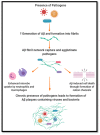The Use of Antimicrobial and Antiviral Drugs in Alzheimer's Disease
- PMID: 32664669
- PMCID: PMC7404195
- DOI: 10.3390/ijms21144920
The Use of Antimicrobial and Antiviral Drugs in Alzheimer's Disease
Abstract
The aggregation and accumulation of amyloid-β plaques and tau proteins in the brain have been central characteristics in the pathophysiology of Alzheimer's disease (AD), making them the focus of most of the research exploring potential therapeutics for this neurodegenerative disease. With success in interventions aimed at depleting amyloid-β peptides being limited at best, a greater understanding of the physiological role of amyloid-β peptides is needed. The development of amyloid-β plaques has been determined to occur 10-20 years prior to AD symptom manifestation, hence earlier interventions might be necessary to address presymptomatic AD. Furthermore, recent studies have suggested that amyloid-β peptides may play a role in innate immunity as an antimicrobial peptide. These findings, coupled with the evidence of pathogens such as viruses and bacteria in AD brains, suggests that the buildup of amyloid-β plaques could be a response to the presence of viruses and bacteria. This has led to the foundation of the antimicrobial hypothesis for AD. The present review will highlight the current understanding of amyloid-β, and the role of bacteria and viruses in AD, and will also explore the therapeutic potential of antimicrobial and antiviral drugs in Alzheimer's disease.
Keywords: Alzheimer’s disease; amyloid-β; antimicrobial; antimicrobial peptide; antiviral.
Conflict of interest statement
The authors declare no conflict of interest.
Figures
Similar articles
-
Does HIV infection contribute to increased beta-amyloid synthesis and plaque formation leading to neurodegeneration and Alzheimer's disease?J Neurovirol. 2019 Oct;25(5):634-647. doi: 10.1007/s13365-019-00732-3. Epub 2019 Mar 13. J Neurovirol. 2019. PMID: 30868421 Review.
-
Multi-pathogen infections and Alzheimer's disease.Microb Cell Fact. 2021 Jan 28;20(1):25. doi: 10.1186/s12934-021-01520-7. Microb Cell Fact. 2021. PMID: 33509204 Free PMC article. Review.
-
The antimicrobial protection hypothesis of Alzheimer's disease.Alzheimers Dement. 2018 Dec;14(12):1602-1614. doi: 10.1016/j.jalz.2018.06.3040. Epub 2018 Oct 9. Alzheimers Dement. 2018. PMID: 30314800
-
Infections, genetics, and Alzheimer's disease: Exploring the pathogenic factors for innovative therapies.Virology. 2025 Jun;607:110523. doi: 10.1016/j.virol.2025.110523. Epub 2025 Mar 27. Virology. 2025. PMID: 40174330 Review.
-
Targeting Infectious Agents as a Therapeutic Strategy in Alzheimer's Disease.CNS Drugs. 2020 Jul;34(7):673-695. doi: 10.1007/s40263-020-00737-1. CNS Drugs. 2020. PMID: 32458360 Free PMC article.
Cited by
-
Unlocking the Protective Potential of Upper Respiratory Infection Treatment Histories against Alzheimer's Disease: A Korean Adult Population Study.J Clin Med. 2024 Jan 2;13(1):260. doi: 10.3390/jcm13010260. J Clin Med. 2024. PMID: 38202267 Free PMC article.
-
Heightened Prevalence of Common Hospital-Treated Infections Preceding Dementia Diagnosis with Accelerated Dementia Onset after Influenza.J Prev Alzheimers Dis. 2024;11(5):1445-1454. doi: 10.14283/jpad.2024.92. J Prev Alzheimers Dis. 2024. PMID: 39350392 Free PMC article.
-
Anti-viral Effects of Pavetta indica Methanolic Extract and Acyclovir on Behavioral and Biochemical Parameters in Streptozotocin-induced Alzheimer's Disease in Rats.Endocr Metab Immune Disord Drug Targets. 2024;24(13):1558-1571. doi: 10.2174/0118715303273145240110100341. Endocr Metab Immune Disord Drug Targets. 2024. PMID: 38685761
-
Warm, Sweetened Milk at the Twilight of Immunity - Alzheimer's Disease - Inflammaging, Insulin Resistance, M. paratuberculosis and Immunosenescence.Front Immunol. 2021 Aug 5;12:714179. doi: 10.3389/fimmu.2021.714179. eCollection 2021. Front Immunol. 2021. PMID: 34421917 Free PMC article. Review.
-
Gut microbiota metabolites: potential therapeutic targets for Alzheimer's disease?Front Pharmacol. 2024 Sep 17;15:1459655. doi: 10.3389/fphar.2024.1459655. eCollection 2024. Front Pharmacol. 2024. PMID: 39355779 Free PMC article. Review.
References
Publication types
MeSH terms
Substances
Grants and funding
LinkOut - more resources
Full Text Sources
Medical



